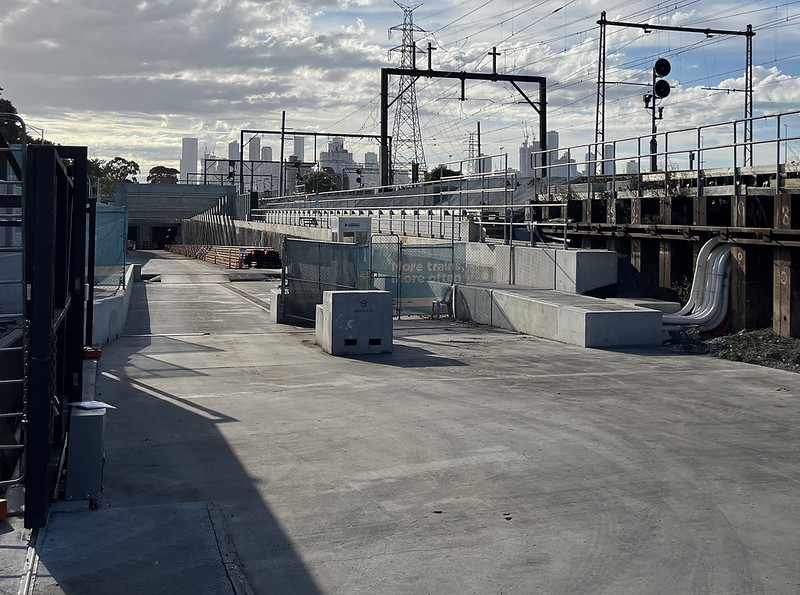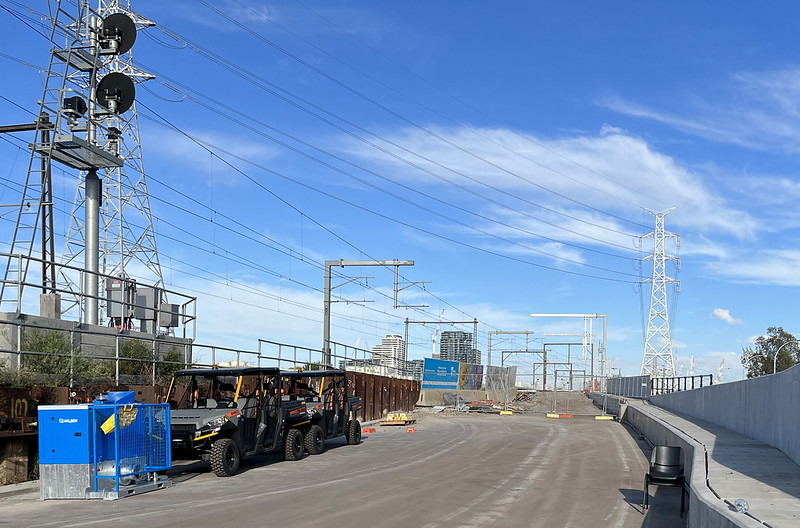Sometimes my walks take me to interesting places.
On Saturday while walking in South Kensington, I found myself at the site of the Metro Tunnel’s western portal.
To my surprise, there was nobody around, no signage saying to stay out, and no closed gate. So I peeked around the corner to snap some photos of the portal itself.
This is where trains from the Sunbury line and the Airport will enter the tunnel heading towards Parkville, then the City.
There’s what appears to be an architectural flourish just before the trains enter the tunnel, with a series of beams over the top of the track. Quite aesthetically pleasing, I think.
On one side of the ramp are rails piled up in preparation for installation.
Nearby were parked what look like tunnel access vehicles. They look quite fun for a spin.
I didn’t venture any further. I had a feeling I was not meant to be there.
Shortly afterwards I sent a DM to the project Twitter account. They came back to me and said it was left open and unattended in error for a short time.
Frankly that’s a relief. You’d hate to see vandals get in and cause damage and/or injure themselves.
Still, from my unauthorised sneak peak, it’s nice to see how that part of the project is progressing. Even from that distance it’s an impressive sight, and it’s great to see it moving ever closer to completion.
- 2019: Portal plans
- It turns out Marcus Wong took a similar photo when passing a few months ago




6 replies on “A peek at the Metro Tunnel western portal”
I’d suspect those beams are purely functional. They look like they are there to support the retaining walls – like the beams do at Ormond. The rail embankment on the right would be quite a large superincumbent weight on the soil, which would tend to push the retaining wall in. The beams act as struts supporting the retaining walls. The alternative would be to make the retaining walls more massive, which would probably cause construction problems with the adjacent railway.
They are architectural as well… Function is form! The modernist architect’s credo.
I’ve taken a couple of train trips into the City in the last few days, and noticed on my trip this morning that the points into the tunnel off the main line are in place – they just need all that new track to be put in place and join them!
@andrew – I was thinking the same thing about the beams.
Perhaps next time you visit a bank, Daniel, everyone will be on a break and the safe will be left open? Help yourself!
@ Steve, the same is so at the South Yarra end too.
If you look closely, not all of the points are in fact in place. All the sleepers are, and some of the rails on the ‘new route’ are, but the point blades are not, and, I think the frog is also not there yet also.
The same is so with the points at West Footscray, and, Hawksburn also.
@ Daniel Bowen, did you happen to count how many sections of rail are there? in that image above, I could count around about 50 of them I trust there would be more.
How many of those rail lengths would the tunnel need?
Is there a chance that, this tunnel will be fully functional before we have enough HCMTs to run the service. If so, what will we do in the meantime? Just not use it until we do get enough HCMTs, or, will we start off with a 50:50 service, with HCMTs through the tunnel, and use Comeng trains on existing route(s) for a year or two?
How many HCMTs would they need to ensure that minimum service level for Sunbury to Cranbourne/Pakenham?
I still think it’s a bad design decision to put the portal off to one side, resulting in a flat junction immediately outside the portal. Why doesn’t Melbourne do grade separated junctions?
The official explanation is that the existing tracks won’t be used once the tunnel is open. I hope that the turnouts they’re installing are rated for 80 km/h on the diverging route so trains won’t have to reduce speed to enter the tunnel.